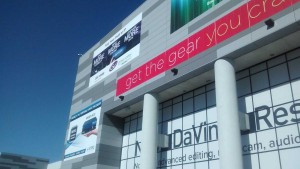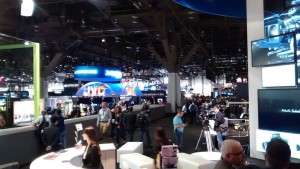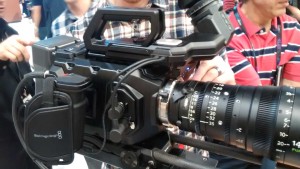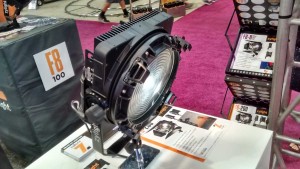 To open with a risky generalization, there now seems to be a realisation that pixel count is neither a particularly good sole indicator of image quality, nor particularly difficult to increase. With Blackmagic Design – a camera manufacturer of only a scant few years’ experience – already promoting an improvement on its existing 4K sensor offering, and with Red promising us 8K during 2016, it’s becoming clearer than ever that acquisition is not, or at least is not purely, a numbers game.
To open with a risky generalization, there now seems to be a realisation that pixel count is neither a particularly good sole indicator of image quality, nor particularly difficult to increase. With Blackmagic Design – a camera manufacturer of only a scant few years’ experience – already promoting an improvement on its existing 4K sensor offering, and with Red promising us 8K during 2016, it’s becoming clearer than ever that acquisition is not, or at least is not purely, a numbers game.
Similarly, in postproduction, headline figures can grow almost as quickly as more and more racks of processing hardware can be persuaded to work in parallel. It’s a particular feature of modern information technology that it often works in teams, and whether it’s Editshare‘s storage products or the 8K might of Quantel‘s Pablo Rio color corrector, the underlying approach is to divide the labor among a large number of individually unremarkable devices. Quantel was at pains to point out that they were the only company offering a system capable of working on 8K material at 60 frames per second. Perhaps the prototypical example of this approach, however, is Filmlight. With their high bandwidth clustering technology, the company made color correction on commodity hardware possible. Thanks to improvements in the underlying technology, most of the Baselight grading systems now sold no longer need to use this approach, which has enabled systems such as the company’s Daylight on-set grading system, shown first at this year’s show. Even so, clustering is still applicable to high bandwidth situations such as extremely high resolutions, high frame rate and stereoscopy.
 Practically all of the ways in which this sort of division of labor can be achieved are based on commodity information technology and the enormous R&D supported by such a broadly-applicable field. While the idea of sending video down computer networks is far from new, another way in which IT was visible at this year’s NAB show was as a direct replacement for the coaxial cable of the ubiquitous HD-SDI video standard. On the face of it, extracting a video frame from an SDI stream and moving it over a 10-gigabit network doesn’t really achieve much, and certainly the extant approach is likely to remain in straightforward situations such as connecting a camera to a monitor on a film set.
Practically all of the ways in which this sort of division of labor can be achieved are based on commodity information technology and the enormous R&D supported by such a broadly-applicable field. While the idea of sending video down computer networks is far from new, another way in which IT was visible at this year’s NAB show was as a direct replacement for the coaxial cable of the ubiquitous HD-SDI video standard. On the face of it, extracting a video frame from an SDI stream and moving it over a 10-gigabit network doesn’t really achieve much, and certainly the extant approach is likely to remain in straightforward situations such as connecting a camera to a monitor on a film set.
However, companies such as Evertz and Harmonic seem very keen to encourage large studio installations to consider 10-gigabit Ethernet as a direct alternative to SDI. There are various advantages to this – easier routing, more flexibility with regard to payload type, and the fact that it can be installed and treated as IT rather than specialist industrial infrastructure. While the bandwidth limits of current common Ethernet installations are a limiting factor, especially as regards higher frame rates or resolutions, anticipated developments in 40- and 100-gigabit Ethernet products are likely to make these things practical. There are complexities – currently there are almost as many standards for broadcast video over IP as there are vendors, and this will need to be addressed, but the field has been growing in visibility for a while and seems on the brink of mainstream adoption, at least in fixed installations.
 Consideration of standout products from this year’s NAB wouldn’t be complete without a covering at least the basics of Blackmagic’s new cameras. These are likely to be well-covered elsewhere, particularly the interesting Ursa Mini, so I’ll limit my comments to this: looks great, shame about the lack of ND filters. It’s also worth a quick mention of their viewfinder, which has largely been overlooked in the storm of excitement over the new sensor announcement. While it’s impossible to prove a negative, this may actually be the first full 1920×1080 electronic viewfinder available (and it can reportedly be used on non-Blackmagic cameras). Among the usual storm of LED releases, Zylight announced a 200-watt version of its F8 fresnel. While the increased output will require fan cooling, this is important because at this power level, the LED fresnel can become genuinely competitive with the ubiquitous one-kilowatt tungsten version. This is not absolutely the only product of its type but LEDs at this power level are, in general, a reasonably recent development. LED lighting of any quality is still far too expensive to be a one-for-one replacement for tungsten, regardless of the brand, but this should be a self-solving problem in time.
Consideration of standout products from this year’s NAB wouldn’t be complete without a covering at least the basics of Blackmagic’s new cameras. These are likely to be well-covered elsewhere, particularly the interesting Ursa Mini, so I’ll limit my comments to this: looks great, shame about the lack of ND filters. It’s also worth a quick mention of their viewfinder, which has largely been overlooked in the storm of excitement over the new sensor announcement. While it’s impossible to prove a negative, this may actually be the first full 1920×1080 electronic viewfinder available (and it can reportedly be used on non-Blackmagic cameras). Among the usual storm of LED releases, Zylight announced a 200-watt version of its F8 fresnel. While the increased output will require fan cooling, this is important because at this power level, the LED fresnel can become genuinely competitive with the ubiquitous one-kilowatt tungsten version. This is not absolutely the only product of its type but LEDs at this power level are, in general, a reasonably recent development. LED lighting of any quality is still far too expensive to be a one-for-one replacement for tungsten, regardless of the brand, but this should be a self-solving problem in time.
It’s impossible not to mention Canon‘s releases, although again, we’ll skim over the C300 Mark II as it’s likely to receive saturation coverage. An uncharitable observer might remark that many of the features of the Mark II – 10-bit output, particularly – are things that one might reasonably have expected to see on the original device, but Canon’s ability to build sensors in-house means that the pictures, based on a subjective assessment on a trade show booth, remain superb. The company has also announced a spectacular new 50-1000mm f4 lens intended primarily for nature documentaries, and it is difficult to argue with Canon’s pedigree in optics.

As ever, a show of this size is hard to sum up, so perhaps we can most informatively return to that thought about resolution. It’s hard to say it doesn’t matter, but as it becomes easier and easier to achieve, it becomes less and less remarkable. With any luck, this will mean that cameramen in general can get back to being hired for their photographic skills, rather than the pixel count offered by the equipment they happen to own.





